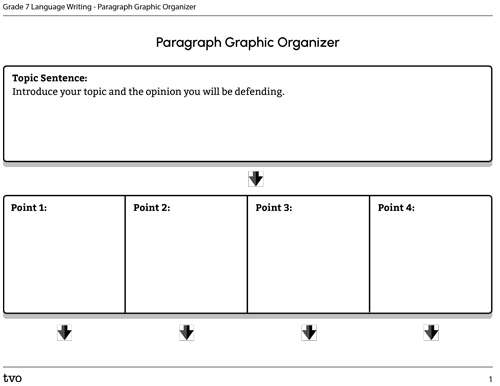Minds On
Organizing ideas
In this learning activity, we are going to improve or develop our paragraph writing skills. By learning how to generate, gather and organize your ideas, you will develop your skills to become an effective writer.
The following sentences were once a complete paragraph, but they have been jumbled! Place them in the correct order using the numbers provided.
Hint: There is more than one possible paragraph!

- Although space exploration is costly and may mean harm to our environment, the rewards may help us avoid or prevent even natural disasters.
- Although countless dangers can occur in space, the rewards of knowledge are priceless.
- Space exploration helps humans discover the universe and what dwells within it other than ourselves.
- Space exploration can be dangerous to the explorers because space lacks gravity and oxygen for humans to breathe.
- Space exploration is costly, and dangerous, but many rewards await us as a species.
- Space exploration is an important way to invent machines to make lives easier for us.
- Scientists can be lost in space or run out of fuel and drift into empty space forever.
Student Success
Think-Pair-Share
Reflect on the following questions after completing the Minds On.
- How did you decide where to put each sentence in the paragraph?
- Is there more than one possible topic sentence? If so, which ones are they? If not, explain why.
- Is there more than one possible concluding sentence? If so, which ones are they? If not, explain why.
If possible, exchange paragraphs with a peer. Compare the two paragraphs. What was the same? What was different?
Note to teachers: See your teacher guide for collaboration tools, ideas and suggestions.
Action
Paragraph structure
You are going to create your own “paragraph puzzle” like the previous one in the Minds On section. First, we will need to write a detailed, well-structured paragraph.
Part 1: Write a paragraph

Step 1: Choose a topic
Choose a topic question from the following list. Notice that they are all questions where one could have a difference in opinion. When you make your selection, think about how you might answer the question. This will eventually become your paragraph.
- Should students be given homework after school every day?
- Should students be allowed to walk-out or protest over a political or social issue?
- Should junk food be allowed to be sold in schools?
- Should video games be part of a school subject?
- Should pets be allowed at school?
- Select your own topic.
Step 2: Generate and research ideas
Once you have your topic, start by generating ideas for both sides of the argument. Complete the Persuasive Writing Graphic Organizer in your notebook or use the following fillable and printable document to write down your ideas. You can use the ideas from the “other side” of the argument to strengthen your own.
You may need to do some research to find more arguments either for or against your topic. Use the following questions to guide you:
- Where can I go to look up information?
- How do I know a website is reliable?
If you are going to use information found from a website, book, video, interview, or elder, you must provide your source. Share where you got the information from.

Press the Activity button to access Persuasive Writing Graphic Organizer.
Activity (Open PDF in a new tab)Step 3: Write your draft
Use the ideas you generated in Step 2 to write your first draft. Throughout this learning activity, you may choose to record your work using speech-to-text software, paper, or a computer. Complete the Paragraph Graphic Organizer in your notebook or use the following fillable and printable document to map out your paragraph.
Once you have organized your paragraph, write your complete draft.
Step 4: Give/receive feedback and make revisions
At this stage, you should have a complete paragraph. Part of the writing process is to go back to your completed work and make changes based on feedback. This is one way we grow as writers.
- Read over your paragraph carefully and out loud, if possible. Make changes based on what you notice.
- If possible, exchange paragraphs with a partner. Share feedback with your partner on what their paragraph does well and what they might want to work on.
Part 2: Construct a paragraph puzzle
Take your paragraph apart, adding each sentence to a new row of a blank table. Place the sentences out of order (for example, you could place your concluding sentence in the second row). You can even add fake or misleading sentences that do not fit your original paragraph!
Use a blank table similar to the following "Paragraph puzzle table." You can draw a similar table in your notebook or use another method of your choice to complete this activity.
Paragraph puzzle table

Consolidation
Constructing meaning
Share your puzzle with someone else, and see if they can piece the paragraph back together. They might create a new paragraph with what you provided. Read it over together, and consider whether it is still a paragraph that makes sense.

Reflection
As you read the following descriptions, select the one that best describes your current understanding of the learning in this activity. Press the corresponding button once you have made your choice.
I feel...
Now, expand on your ideas by recording your thoughts using a voice recorder, speech-to-text, or writing tool.
When you review your notes on this learning activity later, reflect on whether you would select a different description based on your further review of the material in this learning activity.
